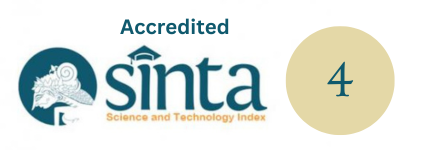Aswamedha: A Legitimation of Leadership Based on The Kitab of Aswamedha Parwa | Aswamedha: Sebuah Legitimasi Kepemimpinan Berbasis Kitab Aswamedha Parwa
DOI:
https://doi.org/10.59997/jurnalsenikarawitan.v2i2.1456Kata Kunci:
Legitimasi, Aswamedha Parwa, komposisi, cakepan.Abstrak
Model legitimasi dengan sarana upacara jarang dilakukan saat ini, oleh karena itu perlunya menarasikan kembali model legitimasi dengan sarana upacara. Tujuan penelitian penciptaan ini adalah, mengungkapkan isian dan menafsirkan model legitimasi kepemimpinan di kitab Aswamedha Parwa melalui komposisi karawitan. Penelitian penciptaan ini menggunakan Teori Transformasi Seni yaitu mentransformasikan karya asli (sastra) menjadi karya baru (komposisi karawitan). Metode penelitian yang digunakan adalah Practice as Research through Performance. Praktek ini dianalogikan menjadi sebuah representasi konteks musikal yaitu analogi tentang kepemimpinan menggunakan bentuk pathetan, analogi tentang kesedihan menggunakn sendhon, analogi tentang kepemimpinan yang legitimate menggunakan bentuk ada-ada. Adapun tahapan yang harus dilalui adalah, Pra Garap, Garap, Pasca Garap. Hasil dari analisa terkait isi komposisi adalah nilai-nilai yang harus dimiliki seorang pemimpin agar kepemimpinannya menjadi legitimate. Nilai-nilai tersebut berimplikasi pada suatu tafsir model komposisi yang mengutamakan cakepan sebagai alat representasi konteks musikal yaitu, pathetan yang memaknai kepemimpinan secara kontekstual, sendhon yang menggambarkan kesedihan seorang pemimpin, ada-ada yang menggambarkan kepemimpinan yang legitimate.
Unduhan
Referensi
Ardana, I. K. (2017). Metode Penciptaan Karya-Karya Baru Karawitan Bali. In Yudiaryani, B. Pudjasworo, B. H. Prasetya, I. W. Senen, M. H. Raditya, & U. Rokhani (Ed.), Karya Cipta Seni Pertunjukan (1 ed., hal. 348–366). Yogyakarta: JB Publisher.
Ardana, I. K. (2020). Representasi Konsep Patet dalam Tradisi Garap Gamelan Bali. Resital: Jurnal Seni Pertunjukan, 21(1), 11–27.
BUDIAPRILLIANA, L., UDIANA NINDHIA PEMAYUN, T., & SUARDINA, I. N. (2017). Transformasi Prasi Tantri Carita Dalam Animasi Prasimotion. Prabangkara : Jurnal Seni Rupa Dan Desain, 21(2). Retrieved from https://jurnal.isi-dps.ac.id/index.php/prabangkara/article/view/230
Ekowati, V. I., Wulan, S. H., Handoko, A., & Insani, H. (2017). Pendidikan Karakter Dalam Iluminasi Naskah Babad Pecinna. Jurnal Penelitian Humaniora, 22(1), 32–44.
Guna, I. W. D. A., & Sujayanthi, N. W. M. (2021). Adapting Copy-Paste Phenomenon Into a New Music. Ghurnita: Jurnal Seni Karawitan, 01(04), 244–253. https://doi.org/10.25124/ghurnita.v1i1.393
Harjudin, L. (2020). Dilema Penanganan Covid-19: Antara Legitimasi Pemerintah Dan Kepatuhan Masyarakat. Werdha Minaula Kendari: Jurnal Kesejahteraan dan Pelayanan Sosial, 1(1), 105–115.
Hastanto Sri. (2009). Konsep Pathet Dalam Karawitan Jawa. (S. Nugroho, Ed.) (1 ed.). Solo: Program Pascasarjana bekerja sama dengan ISI Press Surakarta.
Juliana, I. W., Cika, I. W., & Triadnyani, M. (2017). Tikus Kritikus Dalam Geguritan Yadnya Ring Kuruksetra Karya Dokter Ida Bagus Rai. E-Jurnal Linguistik, Vol.3 No., 1–15.
Nila. (2011). Aswamedha Parwa. (J. Ida, Ed.), ESBE buku. Denpasar: PT. Mahabakti.
Kershaw, B. (2009). Practice as Research through Performance. In Practice as Research through Performance (hal. 104–124). Edinburgh: Edinburg University Press.
Pramana, I. P. R. B., & Suharta, I. W. (2021). Contemporary Music Composition “Konfrontasi.” Ghurnita: Jurnal Seni Karawitan, 01(04), 290–298. https://doi.org/10.25124/ghurnita.v1i1.371
Purwanto, W. E. (2017). Konsep Kepemimpinan Soeharto Dalam Butir-Butir Budaya Jawa. Bahastra, 37(1), 73. https://doi.org/10.26555/bahastra.v37i1.6298
Randyo, M. (2010). Pembinaa Sulukan, Dhodhogan, Dan Kombangan Gending Iringan Pakeliran Di Padepokan Seni Sarotama Sebagai Upaya Peningkatan Unsur Iringan Pakeliran. Abdi Seni: Jurnal Pengabdian Kepada Masyarakat, 2(1), 34–44.
Risna, D. N. W. (2020). Sistem Belajar Otodidak Ekalawya Dalam Adi Parwa. Widyalaya: Jurnal Ilmu Pendidikan, 1(1), 101–108.
Soekarso, & Putong, I. (2015). Kepemimpinan: Kajian Teoritis dan Praktis. Yogyakarta: Mitra Wacana Media.
Sosodoro, B. (2006). Wacana Pathetan. Keteg: Jurnal Pengetahuan, Pemikiran, dan Kajian Tentang Bunyi, 6, 69–87.
Suraji. (2013). Tinjauan Ragam Bentuk Tlutur Dan Korelasinya. Keteg: Jurnal Pengetahuan, Pemikiran, dan Kajian Tentang Bunyi, 13(1), 123–152.
Surbakti, R. (1992). Memahami Ilmu Politik. Jakarta: PT Grasindo.
Suweta, I. M. (2020). Nilai Kehinduan Dalam Geguritan Kuruksetra. Maha Widya Duta, 1–10.
Syaifullah, A. S., Insanitaqwa, P. A. B., & Sofyan, M. (2021). Kepemimpinan Pendidikan Islam. Cerdika: Jurnal Ilmiah Indonesia, 1(7), 867–874. https://doi.org/https://doi.org/10.36418/cerdika.v1i7.126
Teguh. (2014). Kajian Bentuk, Makna dan Fungsi Pathetan Dalam Gending Klenengan. Yogyakarta.
Tetuko, G. (2015). Kajian Musikal Ada-Ada Girisa Versi Ki Manteb Soedharsono. Surakarta.
Wahyudi, S. S. (2011). Kepemimpinan Tradisional Jawa-Islam. Sabda: Jurnal Kajian Kebudayaan, 6(1), 23–29. https://doi.org/https://doi.org/10.14710/sabda.6.1.23-29
Yasa, P. D. (2021). Teologi Kepemimpinan Hindu: Kepemimpinan Berlandaskan Ketuhanan. Khazanah Theologia, 3(1), 13–24. https://doi.org/10.15575/kt.v3i1.10257








